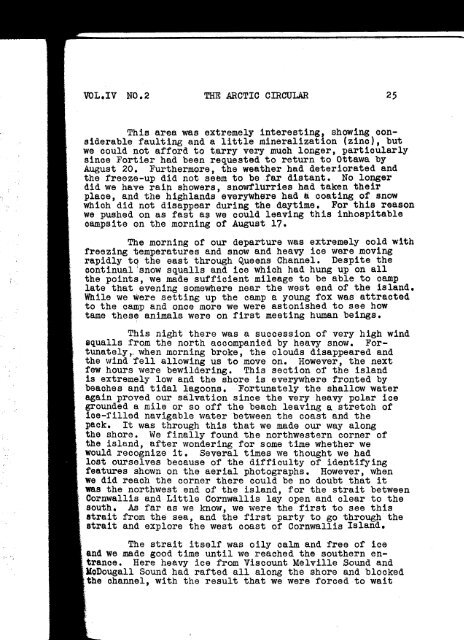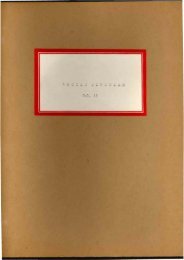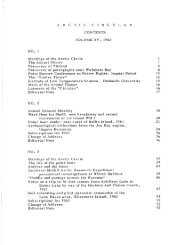Volume 4, 1951 - The Arctic Circle - Home
Volume 4, 1951 - The Arctic Circle - Home
Volume 4, 1951 - The Arctic Circle - Home
You also want an ePaper? Increase the reach of your titles
YUMPU automatically turns print PDFs into web optimized ePapers that Google loves.
This area was extremely interesting, showing oonsiderable<br />
faulting and a little mineralization (zino), but<br />
we oould not afford to t~rry very muoh longer, partloularly<br />
sinoe Fortier had been requested to return to ottawa by<br />
August 20. Furthermore, the weather had deteriorated and<br />
the freeze-up did not seam to befar dIstant. No longer<br />
did we have rain showers, snowflurries had taken their<br />
plaoe, and the highlands everyWhere had a ooating of snow<br />
whIoh did not disappear during the daytime. For this reason<br />
we pushed on as fast as we oould leaving this inhospitable<br />
oampslte on the mornlng of August 17.<br />
<strong>The</strong> morning of our departure was extremely oold with<br />
freezing temperatures and snow and heavy ice were movlng<br />
rapidly tQ the east through ~ueens Channel. Despite the<br />
oontinual 'snow squalls and ioe which had hung up on aIl<br />
the points, we made sufficient mileage to be able to camp<br />
late that evening somewhere near the west end of the Island.<br />
While we were setting up the camp a young fox was attracted<br />
to the camp and onoe more we were astonished to see how<br />
tame these animaIs were on first meeting human beings.<br />
This night there was a sucoession of very high wlnd<br />
squalls from the north accompanied by heavy snow. Fortunately,.<br />
when morning broke, the clouds disappeared and<br />
the wind ~ell allowing us te move on. However, the next<br />
few hours were bewildering. This section of the Island<br />
ls extremely low and the shore is everywhere fronted by<br />
beaches and tidal lagoons.Fortunately the shallow water<br />
again proved our saI vat ion since the very heavy polar ioe<br />
grounded a mile or so off the beach leaving a stretch of<br />
lce-filled navigable water between the coast and the<br />
pack. It was through this that we made our way along<br />
the shore. We finally found the northwestern corner of<br />
the Island, after wondering for some time whether we<br />
would recognize it. Several times we thought we had<br />
lost ourselv6s beoause of the dlfticulty of identifying<br />
features shown on the aerlal photographs. However, when<br />
we dld reach the corner there could be no doubt that it<br />
was the northwest end of the Island, for the strait between<br />
1 Cornwallls and Little Cornwallis lay open and clear to the<br />
south. As far as we know, we were the first to see thls<br />
stralt from the sea, and the tirst party to go through the<br />
stralt and explore the west coast of Cornwallis Island.<br />
<strong>The</strong> strait ltself was oily oalm and free of ice<br />
and we made good time until we reached the southern entrance.<br />
Here heavy lce from Viscount Melville Sound and<br />
,MoDougall Sound had rafted aIl along the shore and blocked<br />
the ohannel, wlth the result that we were forced to walt












